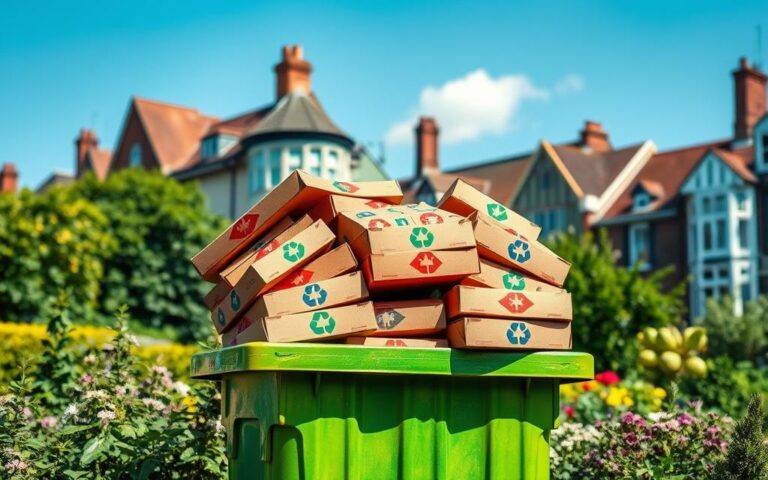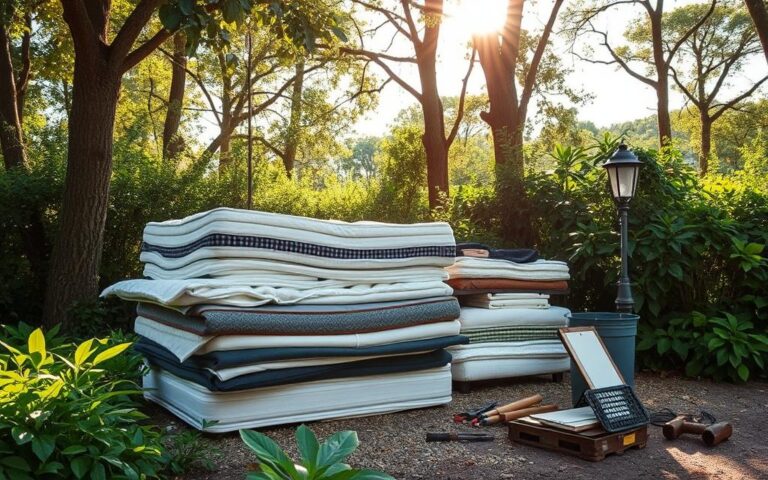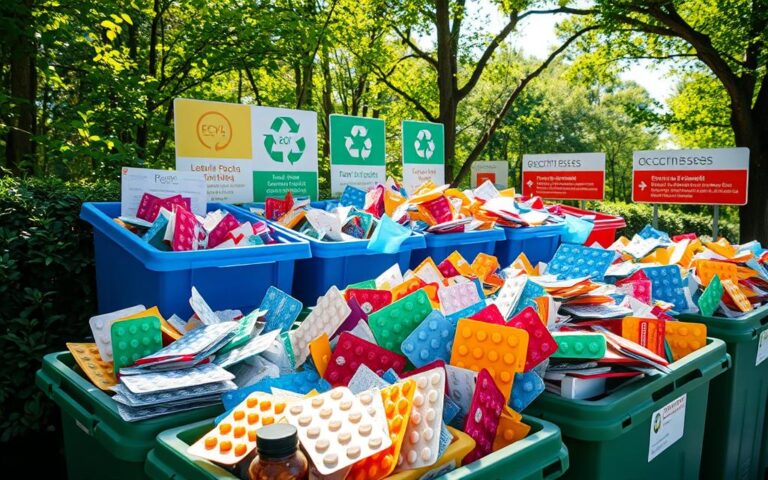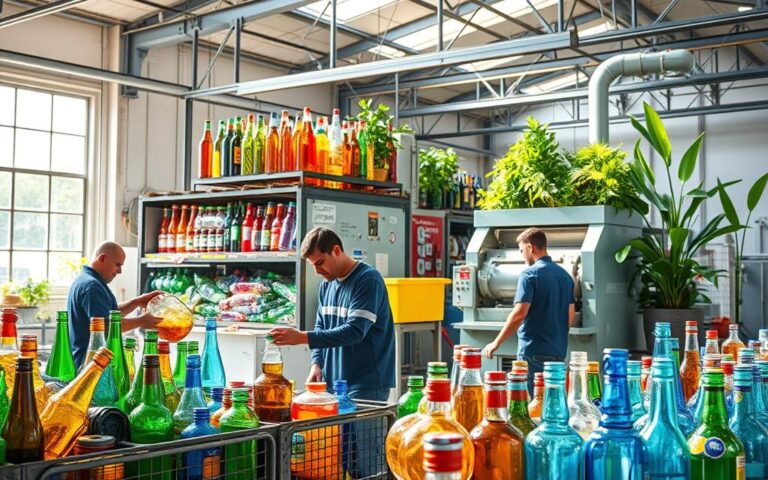Can Wallpaper Be Recycled? What to Know for Disposal
Many homeowners wonder about wallpaper recycling when they’re updating rooms or clearing out excess. Wallpaper feels like it should be recyclable since it’s mostly paper. However, the process gets tricky due to added chemicals and other materials.
Creating washable wallpaper includes adding materials like polythene or vinyl, which hinders eco-friendly wallpaper disposal. Other elements such as glues, inks, and fire-resistant chemicals also stop it from being recycled. In short, you can’t recycle wallpaper in the UK.
Yet, you might find some help with wallpaper disposal through local city councils. They sometimes have special programmes for this. By looking into reusing or repurposing wallpaper, we can cut down on waste. It also allows for interesting decor projects. This introduction aims to kickstart a detailed conversation on the subject.
Understanding Wallpaper Materials
Wallpapers come in different designs and textures. Their make-up is key to how they perform and last. Different materials used in wallpapers lead to various characteristics. This includes how they look and their effect on the environment. Knowing about these materials explains why it’s tough to recycle them using usual methods.
Components of Wallpaper
Wallpaper has several layers, each adding to its structure and quality. The main parts are:
- Backing: This layer adds durability. It comes in woven and non-woven types. Woven backings, made from strong textiles, add firmness. Non-woven backings mix wood pulp and synthetic fibres.
- Ground Coat: This base layer helps in applying printed patterns. It lets designers get creative.
- Inks: Inks put the patterns and pictures on the wallpaper’s surface.
- Protective Coatings: These coatings, made of latex or vinyl, make the wallpaper washable. They help it resist stains better.
Types of Wallpaper Backings
The type of backing affects how you put up and take down the wallpaper. Let’s look at two main types:
| Type of Backing | Characteristics | Common Uses |
|---|---|---|
| Woven | Made from textiles, providing strong support. It can withstand a lot of wear. | Used in busy places and commercial settings. |
| Non-woven | Made from wood pulp and synthetic materials. It’s easier to install and remove. | Great for homes and temporary setups. |
Knowing what wallpapers are made of helps buyers make smarter choices for their homes. It also shows the recycling challenges due to the chemicals and materials used.
Can Wallpaper Be Recycled?
Thinking about if is wallpaper recyclable reveals its recycling difficulty. Wallpaper has many parts, such as backing, ground coat, and inks. Adding paste to the back makes recycling even harder. There are two main types of backing: woven and non-woven, each made from different stuff like textiles or wood pulp.
The stuff in wallpaper affects its recycling wallpaper issues a lot. Many types have polythene or vinyl, blocking the paper recycling process. Also, things like glue, fire-proofing chemicals, and inks stop it from being recycled properly. This leads to big wallpaper recycling challenges.
Its past use, like old plaster or paint, also harms recyclability. Although some wonder about recycling locally, most wallpaper is treated as special waste. Depending on local rules, it might be called residual, bulky, construction, or demolition waste. Small amounts can sometimes go in home rubbish bins. For big amounts, you might need to ask your local council how to throw it away.
To sum up, the many materials and pollutants mean is wallpaper recyclable gets a no. Homeowners should look for other ways to get rid of wallpaper, instead of trying to recycle it.
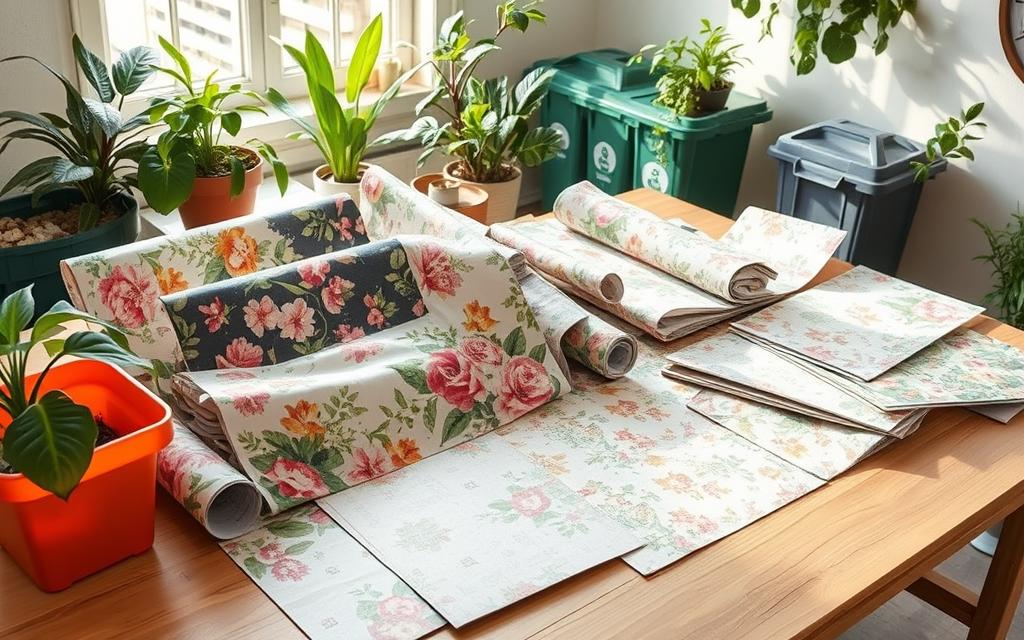
Eco-Friendly Disposal Methods
Disposing of wallpaper eco-friendly involves knowing the methods and local rules. Homeowners help the environment by following the best disposal practices.
Best Practices for Wallpaper Disposal
First, soften the wallpaper with water or a low-VOC remover for easier removal. After taking it down, wrap it in something that can rot away. This stops bad smells or mould.
Most wallpapers have coatings that make recycling hard. So, it’s key to throw them out correctly.
- Follow local waste management guidelines.
- Check for community collection events or recycling programmes for wallpaper.
- Utilise waste disposal associations, as they may accept wallpaper free of charge or for a small fee.
Consulting Local Regulations
It’s key to know your area’s rules for dumping wallpaper. Many councils see it as special waste. Talk to your local council to find the right way to dispose of it. Some places might charge a small fee for taking wallpaper, while others will pick it up with regular trash.
Repurposing and Reusing Wallpaper
Repurposing wallpaper opens up new creative chances. Rather than throwing old wallpaper away, think about its potential uses. Wallpaper is great for lots of projects. It helps cut down waste and adds style to your home.
Creative Ways to Use Old Wallpaper
Old wallpaper can be reused in many fun projects. Here’s how to give wallpaper a new purpose:
- Wrap gifts in wallpaper to make them unique.
- Line drawers or shelves with wallpaper to make them look stylish.
- Use bits of wallpaper for handmade cards or scrapbooks.
- Give furniture a new life with a layer of wallpaper.
- Create decorative bowls or party decorations from wallpaper.
Craft Projects with Wallpaper
For craft lovers, there are lots of wallpaper project ideas. DIY fans share tips for using leftover wallpaper creatively. For example:
- Sarah from Thrifty Decor Chick lists ten ways to use scraps.
- Andrea from The Cottage Market shows projects for all abilities.
- Tania from Run to Radiance talks about using vintage wallpaper.
- Angie from Postcards from the Ridge explains how to update furniture with wallpaper.
It’s easy to find ideas for wallpaper crafts online. Look for leftover samples, or check with friends and thrift stores.
Conclusion
While we may like the idea of recycling wallpaper, it’s often not possible because of its complex makeup. We need to look at eco-friendly ways to handle wallpaper. This includes throwing it away responsibly or finding new uses for it.
Doing our bit for the environment means choosing sustainable practices. Thinking about how we dispose of wallpaper helps. By being mindful, we can help our planet even without recycling.
Our main aim is to make smart choices and find new ways to use old materials. We all need to work together to act more eco-friendly. Let’s choose to live in a way that’s better for our Earth.
FAQ
Can wallpaper be recycled?
No, wallpaper can’t be recycled. This is because it’s made of different materials and chemicals. These include vinyl, adhesives, and inks, making recycling difficult.
What are the options for disposing of old wallpaper?
For old wallpaper, start by soaking it with water or a safe paint remover. This makes it easier to take off. Then, you can throw it away with your regular trash. But, it’s a good idea to check with your local council. They may have special rules or recycling programs you can use.
What materials are used in wallpaper?
Wallpaper is made up of several layers. These layers include a backing and a ground coat, alongside the applied inks. Sometimes, there’s also a latex or vinyl coating for protection. The type of backing used, whether woven or non-woven, affects how tough the wallpaper is.
Are there eco-friendly methods to dispose of wallpaper?
Indeed, there are greener ways to throw away wallpaper, even if you can’t recycle it. Local councils often have eco-friendly suggestions. Another idea is to reuse or repurpose your wallpaper. This way, its lifespan is extended in a creative manner.
What creative ways can I use old wallpaper?
Old wallpaper can be turned into gift wrap or used to line furniture drawers beautifully. You can also get crafty with it. Try making custom greeting cards or scrapbook pages. This shows just how versatile and eco-friendly it can be.
How can I prevent odours or mould from leftover wallpaper?
To stop bad smells or mould on leftover wallpaper, make sure it’s completely dry before you throw it away. Always store any leftovers in a place with good airflow until you can dispose of them.












